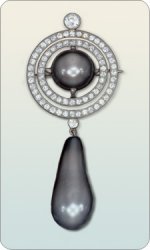Caitlin
Well-known member
http://www.gia.edu/events/29547/allure_of__pearls__featured_pearls_p_1.cfm
http://www.mnh.si.edu/exhibits/Pearls/blackbeauty1.htm
Below is a picture of the Drexel Pearl from the GIA link above. The picture is originally from the Smithsonian exhibit, but doesn't seem to be in the Smithsonian link.
http://www.mnh.si.edu/exhibits/Pearls/blackbeauty1.htm
Below is a picture of the Drexel Pearl from the GIA link above. The picture is originally from the Smithsonian exhibit, but doesn't seem to be in the Smithsonian link.
The Drexel Pearl is named after Mary S. Irick Drexel, a well-known philanthropist, passionate jewelry collector, and patroness of the arts. Born in 1868, Ms. Drexel commissioned Cartier of America to make the Belle Epoque pendant-brooch in 1905. She and her husband, George W. Childs Drexel, later became well known for their support of Drexel University.
Although the exact origin of this one-of-a-kind pearl is unknown, it was likely found in French Polynesia. Since the French became a protectorate of Polynesia in the mid-1800's, it is likely that fine pearls at this time made their way back to France, and leading jewelers such as Cartier incorporated them into jewelry.
In this stunning beauty, you can't help but notice its remarkable gray color and pink overtones.
The subtle gray bodycolor serves as the perfect background for the iridescent colors that result from the interaction of incident light with the pearl's nacre. Its exquisite color combined with its long symmetrical shape and smooth surface make it a rare addition to the collection.
It is extremely rare to see this type of world-class natural pearl being traded today, as their recovery is now virtually non-existent.
Top Pearl: Size: 12.85 x 12.90 x 10.30 mm
Weight: 48 grains (12 carats)
Bottom Pearl:
Size: 29.00 x 13.65 x 12.20 mm
Weight: 135.2 grains (33.8 carats)
Lender: Andrew Cohen S.A. of Geneva, Switzerland
Attachments
Last edited:

